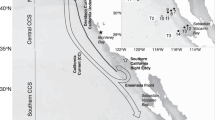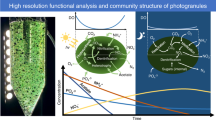Abstract
Carbon and nitrogen fluxes in Aphanizomenon sp. colonies in the Baltic Sea were measured using a combination of microsensors, stable isotopes, mass spectrometry, and nanoscale secondary ion mass spectrometry (nanoSIMS). Cell numbers varied between 956 and 33 000 in colonies ranging in volume between 1.4 × 10−4 and 230 × 10−4 mm−3. The high cell content and their productivity resulted in steep O2 gradients at the colony–water interface as measured with an O2 microsensor. Colonies were highly autotrophic communities with few heterotrophic bacteria attached to the filaments. Volumetric gross photosynthesis in colonies was 78 nmol O2 mm−3 h−1. Net photosynthesis was 64 nmol O2 mm−3 h−1, and dark respiration was on average 15 nmol O2 mm−3 h−1 or 16% of gross photosynthesis. These volumetric photosynthesis rates belong to the highest measured in aquatic systems. The average cell-specific net carbon-fixation rate was 38 and 40 fmol C cell−1 h−1 measured by microsensors and by using stable isotopes in combination with mass spectrometry and nanoSIMS, respectively. In light, the net C:N fixation ratio of individual cells was 7.3±3.4. Transfer of fixed N2 from heterocysts to vegetative cells was fast, but up to 35% of the gross N2 fixation in light was released as ammonium into the surrounding water. Calculations based on a daily cycle showed a net C:N fixation ratio of 5.3. Only 16% of the bulk N2 fixation in dark was detected in Aphanizomenon sp. Hence, other organisms appeared to dominate N2 fixation and NH4+ release during darkness.
Similar content being viewed by others
Log in or create a free account to read this content
Gain free access to this article, as well as selected content from this journal and more on nature.com
or
References
Berman-Frank I, Lundgren P, Chen YB, Kupper H, Kolber Z, Bergman B et al. (2001). Segregation of nitrogen fixation and oxygenic photosynthesis in the marine cyanobacterium Trichodesmium. Science 294: 1534–1537.
Broecker WS, Peng TH . (1974). Gas exchange rates between air and sea. Tellus 26: 21–35.
Carlton RG, Pearl HW . (1989). Oxygen induced changes in morphology of aggregates of Aphanizomenon flos-aquae (Cyanophyceae): implications for nitrogen fixation potentials. J Phycol 25: 326–333.
Degerholm J, Gundersen K, Bergman B, Söderbäck E . (2006). Phosphorus-limited growth dynamics in two Baltic Sea cyanobacteria, Nodularia sp. and Aphanizomenon sp. FEMS Microbiol Ecol 58: 323–332.
Degerholm J, Gundersen K, Bergman B, Söderbäck E . (2008). Seasonal significance of N2 fixation in coastal and offshore waters of the northwestern Baltic Sea. Mar Ecol Prog Ser 360: 73–84.
Finzi-Hart JA, Pett-Ridge J, Weber PK, Popa R, Fallon SJ, Gunderson T et al. (2009). Fixation and fate of C and N in the cyanobacterium Trichiodesmium using nanometer-scale secondary ion mass spectrometry. Proc Natl Acad Sci 106: 6345–6350.
Gallon JR, Evans AM, Jones DA, Albertano P, Congestri R, Bergman B et al. (2002). Maximum rates of N2 fixation and primary production are out of phase in a developing cyanobacterial bloom in the Baltic Sea. Limnol Oceanogr 47: 1514–1521.
Glibert PM, Bronk DA . (1994). Release of dissolved organic nitrogen by marine diazotrophic cyanobacteria, Trichodesmium spp. Appl Environ Microbiol 60: 3996–4000.
Hajdu S, Höglander H, Larsson U . (2007). Phytoplankton vertical distributions and composition in Baltic Sea cyanobacterial blooms. Harmful Algae 6: 189–205.
Helcom (Helsinki commission) (1988). Guidelines for the Baltic Monitoring Programme for the Third Stage, Part D. Biological Determinants. Balt Sea Environ Proc 27 D, Baltic Marine Environment Protection Commission: Helsinki, pp 23–54.
Ibelings BW, Maberly SC . (1998). Photoinhibition and the availability of inorganic carbon restrict photosynthesis by surface blooms of cyanobacteria. Limnol Oceanogr 43: 408–419.
Jørgensen BB, Revsbech NP, Cohen Y . (1983). Photosynthesis and structure of benthic microbial mats: microelectrode and s.e.m. studies of four cyanobacterial communities. Limnol Oceanogr 28: 1075–1093.
Kiørboe T, Grossart H-P, Ploug H, Tang K . (2002). Mechanisms and rates of bacterial colonization of sinking aggregates. Appl Environ Microbiol 68 (8): 3996–4006.
Larsson U, Hajdu S, Walve J, Elmgren R . (2001). Baltic Sea nitrogen fixation estimated from the summer increase in upper mixed layer total nitrogen. Limnol Oceanogr 46: 811–820.
Lassen C, Ploug H, Jørgensen BB . (1992). Microalgal photosynthesis and spectral scalar irradiance in coastal marine sediments of Limfjorden, Denmark. Limnol Oceanogr 37: 760–772.
Libicki SB, Salmon PM, Robertson CR . (1988). The effective diffusive permeability of a nonreacting solute in microbial cell aggregates. Biotechnol Bioeng 32: 68–85.
Li Y-H, Gregory S . (1974). Diffusion of ions in sea water and in deep-sea sediments. Geochim Cosmochim Acta 38: 703–714.
Mass LRM . (1994). On the surface area of an ellipsoid and related integrals of elliptic integrals. Comput Appl Math 51: 237–249.
Moisander PH, Steppe TF, Hall NS, Kuparinen J, Pearl HW . (2003). Variability in nitrogen and phosphorus limitation for Baltic Sea phytoplankton during nitrogen-fixing cynobacteria blooms. Mar Ecol Prog Ser 262: 81–95.
Montoya JP, Voss M, Kahler P, Capone DG . (1996). A simple, high-precision, high-sensitivity tracer assay for N2 fixation. Appl Environ Microb 62: 986–993.
Mulholland MR, Capone DG . (1996). Stoichiometry of nitrogen utilization in cultured populations of Trichodesmium IMS101: implications for growth. Limnol Oceanogr 46: 436–443.
Musat N, Halm H, Winterholler B, Hoppe P, Peduzzi S, Hillion F et al. (2008). A single-cell view on the ecophysiology of anaerobic phototrophic bacteria. PNAS 105: 17861–17866.
Ohlendieck U, Stuhr A, Siegmund H . (2000). Nitrogen fixation by diazotrophic cyanobacteria in the Baltic Sea and transfer of the newly fixed nitrogen to picoplankton organisms. J Mar Sys 25: 213–219.
Ploug H . (2008). Cyanobacterial aggregates formed by Aphanizomenon sp. and Nodularia spumigena in the Baltic Sea: small-scale fluxes, pH and oxygen microenvironments. Limnol Oceanogr 53: 914–921.
Ploug H, Grossart H-P . (1999). Bacterial production and respiration in suspended aggregates—a matter of the incubation method. Aquat Microb Ecol 20: 21–29.
Ploug H, Kühl M, Buchholz B, Jørgensen BB . (1997). Anoxic aggregates—an ephemeral phenomenon in the ocean. Aquat Microbol Ecol 13: 285–294.
Popa R, Weber PK, Pett-Ridge J, Finzi JA, Fallon SJ, Hutcheon ID et al. (2007). Carbon and nitrogenfixation and metabolite exchange in and between individual cells of Anabaena oscillarioides. ISME J 1: 354–360.
Revsbech NP . (1989). An oxygen microelectrode with a guard cathode. Limnol Oceanogr 34: 474–478.
Reynolds CV, Walsby AE . (1975). Water blooms. Biol Rev 50: 437–481.
Rolff C, Almesjö L, Elmgren R . (2007). Nitrogen fixation and abundance of the diazotrophic cyanobacterium Aphanizomenon sp. in the Baltic Proper. Mar Ecol Prog Ser 332: 107–118.
Stal LJ, Albertano P, Bergman B, von Bröckel K, Gallon JK, Hayes PK et al. (2003). BASIC: Baltic Sea Cyanobacteria. An investigation of the structure and dynamics of water blooms of cyanobacteria in the Baltic Sea-resposes to a changing environment. Cont Shelf Res 23: 1695–1714.
Stal LJ, Walsby AE . (2000). Photosynthesis and nitrogen fixation in a cyanobacterial bloom in the Baltic Sea. Eur J Phycol 35: 97–108.
Stal LJ, Staal M, Villbrandt M . (1999). Nutrient control of cyanobacterial blooms in the Baltic Sea. Mar Ecol Prog Ser 18: 165–173.
Villbrant M, Stal LJ, Krumbein WE . (1990). Interactions between nitrogen fixation and oxygenic photosynthesis in a marine cyanobacterial mat. FEMS Microb Ecol 74: 59–72.
Walve J, Larsson U . (2007). Blooms of Baltic Sea Aphanizomenon sp.(Cyanobacteria) collapse after internal phosphorus depletion. Aquat Microb Ecol 49: 57–69.
Walsby AE, Hayes PK, Boje R, Stal L . (1997). The selective advantage of buoyancy provided by gas vesicles for planktonic cyanobacteria in the Baltic Sea. New Phytol 136: 407–417.
Wannicke N, Koch BP, Voss M . (2009). Release of fixed N2 and C as dissolved compounds by Trichodesmium erythreum and Nodularia spumigena under the influence of high light and high nutrient (P). Aquat Microb Ecol 57: 175–189.
Warembourg FR . (1993). Nitrogen isotopes techniques. In: Knowles K., Blackburn TH (eds). Nitrogen Fixation in Soil and Plant Systems. Academic: New York. pp 157–180.
Wasmund N, Voss M, Lochte K . (2001). Evidence of nitrogen fixation by non-heterocystous cyanobacteria in the Baltic Sea and re-calculation of a budget of nitrogen fixation. Mar Ecol Prog Ser 214: 1–14.
Acknowledgements
This study was supported by a Marie Curie Fellowship to HP (AHICA; 219976) and the Max Planck Society. We thank the staff at the Marine Science Center (Askö Laboratory) and Marcel Günter for assistance in the field and in the laboratory. Malin Mohlin is thanked for advice using the counting chamber. We also thank three anonymous reviewers for their thoughtful comments to the manuscript.
Author information
Authors and Affiliations
Corresponding author
Rights and permissions
About this article
Cite this article
Ploug, H., Musat, N., Adam, B. et al. Carbon and nitrogen fluxes associated with the cyanobacterium Aphanizomenon sp. in the Baltic Sea. ISME J 4, 1215–1223 (2010). https://doi.org/10.1038/ismej.2010.53
Received:
Revised:
Accepted:
Published:
Issue date:
DOI: https://doi.org/10.1038/ismej.2010.53
Keywords
This article is cited by
-
Stable Carbon and Nitrogen Isotope Composition in Suspended Particulate Matter Reflects Seasonal Dynamics of Phytoplankton Assemblages in the Gulf of Riga, Baltic Sea
Estuaries and Coasts (2022)
-
Purple sulfur bacteria fix N2 via molybdenum-nitrogenase in a low molybdenum Proterozoic ocean analogue
Nature Communications (2021)
-
Small phytoplankton contribute greatly to CO2-fixation after the diatom bloom in the Southern Ocean
The ISME Journal (2021)
-
Nitrogen fixation estimates for the Baltic Sea indicate high rates for the previously overlooked Bothnian Sea
Ambio (2021)
-
Distinct nitrogen cycling and steep chemical gradients in Trichodesmium colonies
The ISME Journal (2020)



